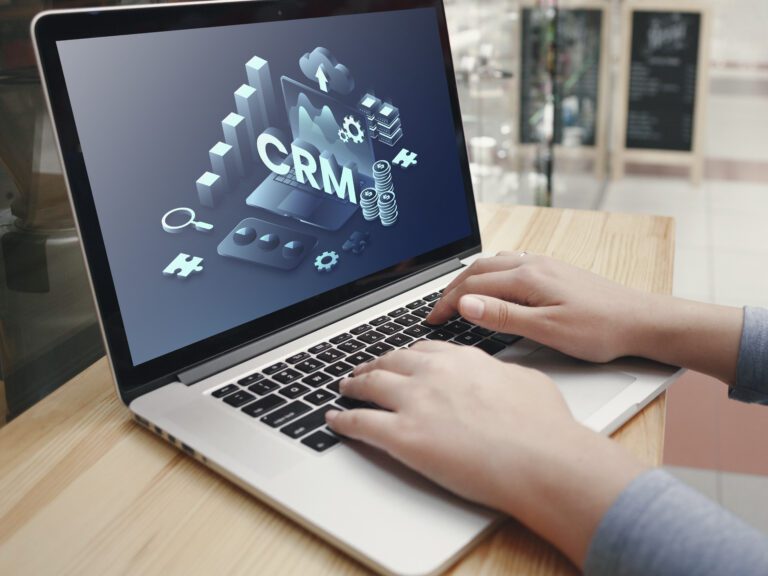25 Proven Methods on How to Increase Website Traffic and Get Leads

I hope you enjoy this blog post. If you want Hello Bar to grow your leads, click here.
Author:
Ryan Bettencourt
Published
August 9, 2024

After creating a website, the most crucial step is knowing how to increase website traffic. In today’s fiercely competitive online marketplace, a strong online presence is essential to improve visibility, drive traffic, generate leads, and stay ahead of industry trends.
Yet, many marketers and business owners find it challenging to attract and convert website visitors. In fact, 61% of marketers consider driving traffic and generating leads their greatest challenge.
The good news is that learning how to increase website traffic is easier than you think. With a solid marketing strategy, you can efficiently boost your online visibility and maximize your ROI.
In this article, we’ll outline a step-by-step process to show you how to drive more traffic to your website and generate quality leads.
Website Traffic Statistics and Curious Facts
Here are the top eye-opening statistics and curious facts about website traffic to help guide your digital marketing efforts this year:
- As of 2024, there are over 5.44 billion internet users across the world. This represents about 67.1% of the global population.
- Approximately half of the world’s website traffic comes from mobile phones. In the last quarter of 2023, these devices (excluding tablets) generated 58.67% of global website traffic.
- About 5 million blogs are published daily
- Google dominates the web search, accounting for over 91% of all search traffic. The platform receives 84.2 billion monthly visitors
WordPress is the most popular CMS, attracting over 409 million visitors and 20 billion page views each month (see image below)
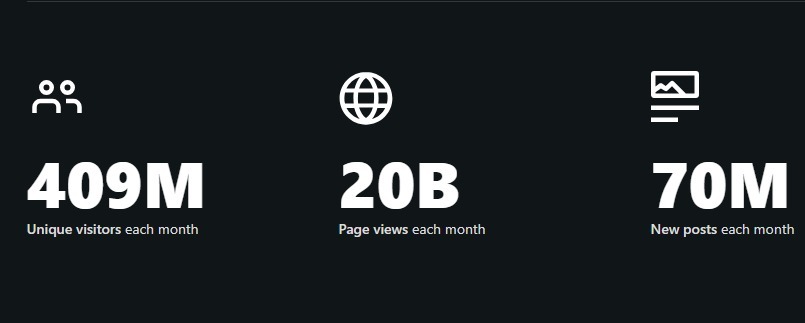
Image via WordPress
Those are some pretty big numbers. However, many other websites only get a few visits daily, despite the billions of people they can attract.
Benefits of Boosting Your Website Traffic
When it comes to digital marketing, having increased website traffic is fundamental. Let’s look at the key reasons why driving more traffic to your website is essential:
Enhanced Brand Visibility
When your site consistently appears on search engine results pages or on social media, people will start to recognize your brand and understand your brand offerings. This increased exposure will make it easier for them to learn about your business.
Higher Lead Generation
By strategically driving more traffic to your website, you increase the chances of converting your website visitors into leads. With a larger pool of leads, you improve the chances of turning these leads into paying customers.
Increased Sales and Revenue
Boosting your site’s traffic means that more potential customers will have the opportunity to view your products or services. This can result in more sales and revenue for your business.
Broader Market Reach
The higher your site ranks in search results, the more likely your potential clients and customers will discover your website online. A strong online presence dramatically increases your chances of attracting and connecting with potential customers.
You May Also Like:
- 9 Strategies on How to Generate Leads from Your Website
- Getting More Leads from Your Blog Traffic (Steps Included)
25 Proven Methods on How to Increase Website Traffic
If SEO is the key to increasing website traffic, how do you put in place a smart strategy? That’s the question many marketers and business owners struggle to answer.
Believe it or not, many entrepreneurs don’t have an SEO strategy. They create websites, write content, and hope for the best.
Sometimes, they succeed. You never know, right? But we’d rather develop a winning strategy to position our business to succeed every time.
Now that we know how important SEO is in increasing traffic, let’s explore 25 proven methods to boost your own traffic without wasting your valuable time.
1. Search Engine Optimization
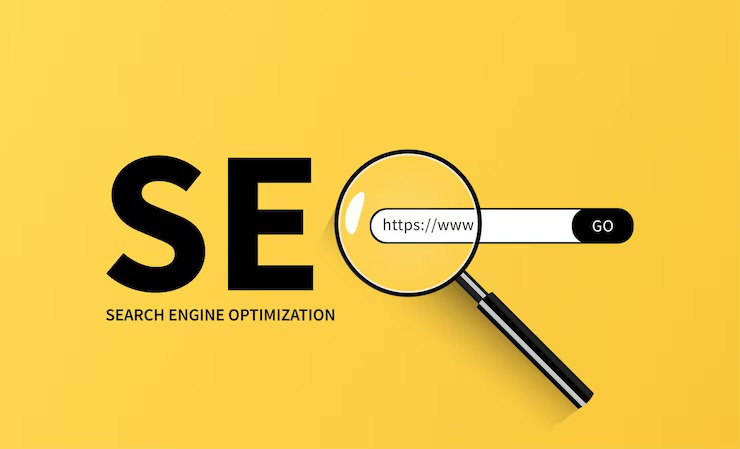
Image via Freepik
Search engine optimization (SEO) is an essential strategy to increase website traffic. SEO is the process of improving a website to make it more visible and rank higher in search engine results pages (SERPs).
The primary goal of SEO is to attract organic traffic to your website by making it more appealing to search engines like Google, Yahoo, and Bing.
Below are three ways you can effectively optimize your website for SEO:
- Create valuable and relevant content that addresses the needs and interests of your target audience
- Acquire quality backlinks from reputable websites in your industry
- Integrate relevant keywords naturally into your website content
You May Also Like:
- SEO For Lead Generation: How To Skyrocket Organic Leads
- 23 Ecommerce Optimization Tips to Greatly Increase Conversion Rates
2. Content Marketing

Content marketing is one of the pillars of any successful digital marketing strategy.
When you create and distribute relevant, valuable, and consistent content, you’ll likely attract and retain a clearly defined audience that you can convert to customers.
Let’s discuss how you can leverage content marketing to increase website traffic and generate leads:
- Regularly publish high-quality blog content, focusing on relevant topics that address your audience’s pain points
- Write guest posts for reputable and relevant websites in your industry
- Create valuable and engaging videos such as tutorials, product recommendations, and how-to guides
- Embed Instagram profile on website to display user-generated content and brand updates, enhancing engagement and building trust with visitors
3. Social Media Marketing
Research from GWI reveals that the average social media user spends 143 minutes daily using social media platforms.
Businesses that understand how to leverage these platforms can significantly boost their social media presence and engagement.
The key is to determine the social media platform that best suits your message.
This can vary depending on your business model and target audience. For instance, LinkedIn is an excellent choice if you’re looking to promote a webinar to a professional audience.
Instagram, on the other hand, is ideal for visual-driven content, such as behind-the-scene photos and product imagery (see image below).

Image via Instagram
Here are key social media marketing strategies you can implement to drive relevant traffic:
- Share posts that are informative, entertaining, and visually appealing
- Use popular and trending hashtags in your industry to reach a broader audience
- Use scheduling tools to plan and automate your posts to ensure consistency
You May Also Like:
- How To Get Followers on Instagram – 2020 Complete Guide
- Social Media Strategy: 6 Easy Ways to Write Fresh Social Media Posts for a Single Blog Post
4. Email Marketing
Even with the rise of social media and other digital marketing channels, email marketing remains one of the most effective traffic drivers.
With more than 4 billion active email users globally, you can use this platform to target your audience and drive people to your web pages.
Here’s how:
- Build a quality email list: Grow your list organically through opt-in forms on your website, social media, and landing pages.
- Craft a compelling subject line: Your subject line is the first thing recipients see. Ensure it’s clear, engaging, and promises value.
- Personalize your content: Use segmentation to send targeted emails based on user preferences, past interactions, and demographic information.
The email newsletter below is a great example of email marketing in action:

Image via Really Good Emails
5. PPC Advertising
Pay-Per-Click (PPC) advertising is a powerful way to quickly drive targeted traffic to your site.
With this type of paid advertising, you bid for ad placements in a search engine’s sponsored links. When someone searches for a keyword related to your business, your ad will appear at the top of search results.
Once they click on the ad, the PPC ad directs them to a landing page on your website. This page should be relevant to the ad, load quickly, and have a clear CTA to increase conversion rates.
Here’s an example of a PPC ad campaign on Google:
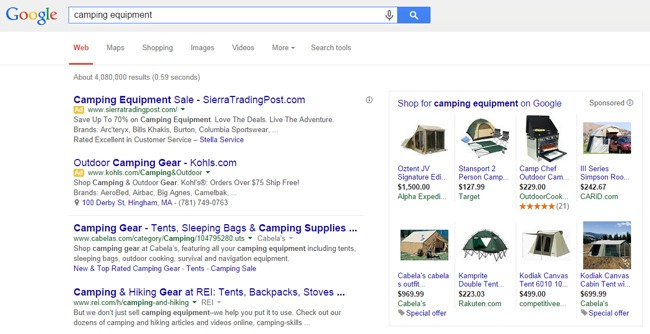
Image via Google
6. Affiliate Marketing
This remains one of the most effective strategies for driving traffic to your site. It’s a performance-based model that involves partnering with affiliates.
These affiliates will promote your products or services in exchange for a commission on each sale or lead they generate.
The first step to effectively leverage affiliate marketing is to choose the right affiliates. Look for bloggers, influencers, or websites with strong engagement in your niche. Their endorsement can drive relevant traffic to your site.
7. Host Giveaway
Everyone loves free stuff, right? Why not use that to your advantage?
Give away a bundle of your products, one month of free access to your membership site, gift cards, or a free trial of your service.
Hosting a giveaway combines the elements of value and excitement, which can help attract new and existing visitors to your site.
Here’s an excellent example of a business hosting a giveaway on their website:
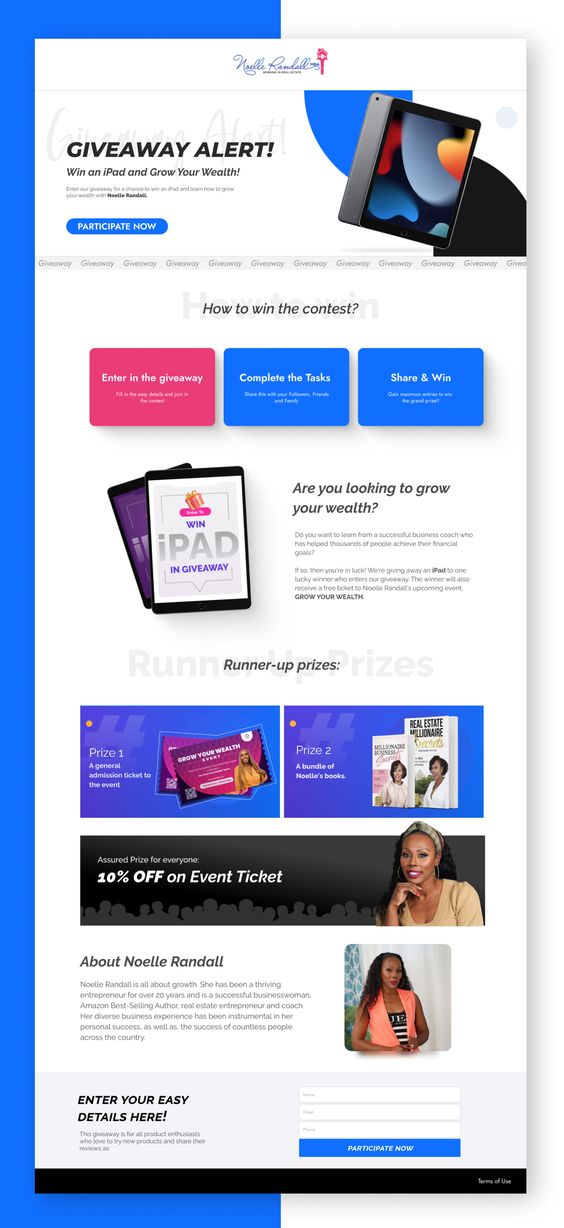
Image via Pinterest
To maximize its impact, ensure you promote your giveaway on multiple social media platforms. You can even offer additional entries to people who promote it for you on their blogs and social profiles.
8. Online Communities
We certainly couldn’t forget to discuss online communities. These digital spaces unite like-minded people who share interests, questions, and solutions around a particular topic or niche.
Popular platforms like Reddit, Facebook Groups, and LinkedIn Groups are excellent places to explore.
We love how Degardo used Reddit to ask for feedback on its store. They’ve thoughtfully added a link to their website, which will help drive traffic when the users click through it.
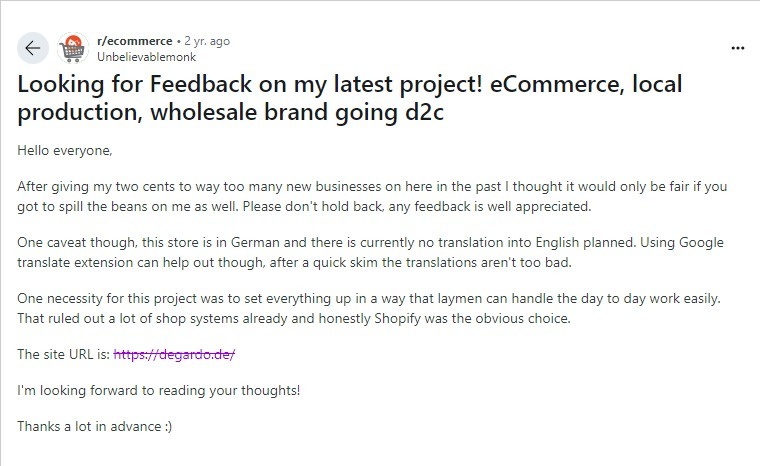
Image via Reddit
Remember to use keywords related to your business to search for active groups with a huge following and high engagement levels.
You May Also Like:
- How To Create And Maintain Brand Loyalty Like a Pro in 2024
- How to Get Facebook Followers and Greatly Increase Your Social Presence
9. Local SEO and Listings
Optimizing your website for local search results is an essential strategy to attract customers in your area. By optimizing your website for local search results and applying SEO for local businesses, you can significantly increase your visibility to reach potential customers who are searching for your offerings nearby.
You can do optimize your website for local search by:
- Incorporating local keywords into your site’s content, tags, and meta description.
- Submitting your business to online directories like Yelp and Yellow Pages.
- Completing your Google My Business (GMB) listing with relevant information, such as your business name, address, business phone number, and website (see image below).
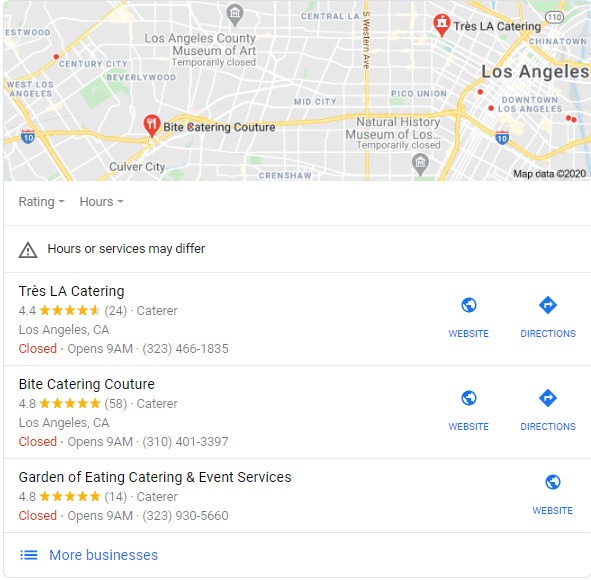
Image via Google
10. Content Syndication
Content syndication is a great way to drive website traffic. It involves republishing your content on third-party websites, reaching a wider audience that may not visit your site directly.
Consider posting one of your older articles on LinkedIn with a link back to your homepage or the original.
Just don’t forget to update the older article. If it contains old statistics or references, freshen it up so you don’t lose credibility with your LinkedIn followers.
11. Networking
Building and maintaining professional relationships can open doors to several opportunities that drive relevant traffic to your website.
Trade shows, industry conferences, and networking events are great places to meet potential partners, clients, and influencers in your field.
You can also leverage social media platforms like LinkedIn, Twitter, and Facebook. Join industry-specific groups, participate in discussions, and share valuable content. Such engagements can help drive traffic to your site.
12. Webinars and Live Events
In today’s digital age, webinars and live events have become tools for businesses looking to engage their audience, establish authority, and generate leads.
These platforms are excellent for interacting with your audience. You can teach them valuable information, allow them to ask questions, and provide them with a coupon code or discount.
They don’t take much time — typically one to two hours — and you can repost them later on your social channels to drive more traffic.
To make your events have greater reach, you can even turn your webinar or online event into a hybrid one using virtual events platforms such as RingCentral Events.
Here’s a great webinar landing page example from McLean Hospital:
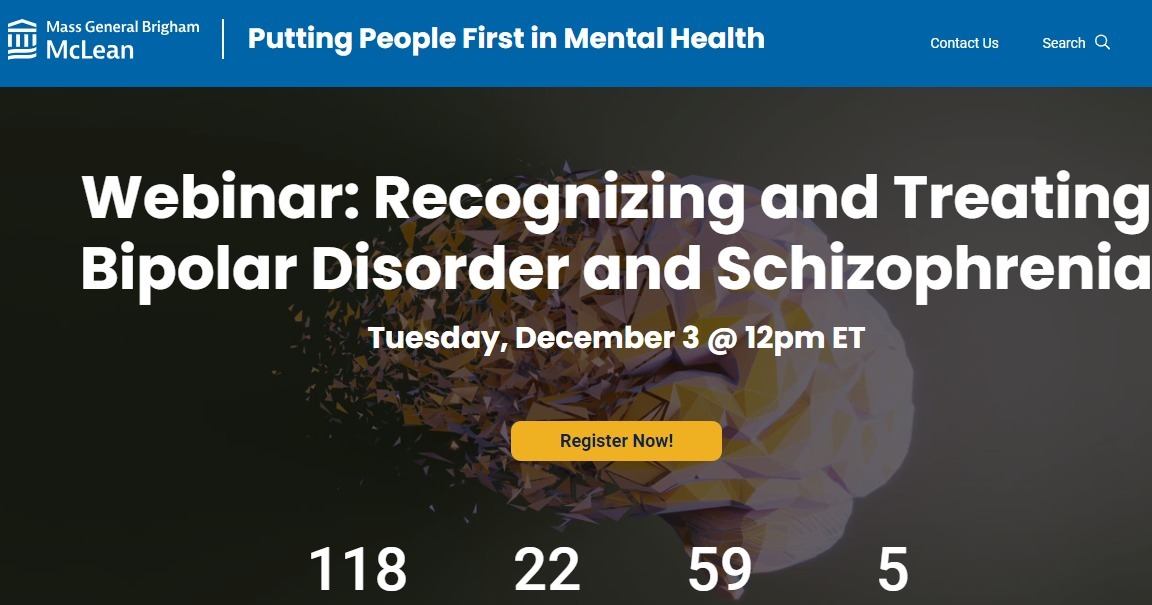
Image via McLean Hospital
You May Also Like:
- How Long Does It Take to Build a Website? Everything You Need
- 11 Benefits of Conversion Rate Optimization and Best Practices
13. Analytics

Some people like to read long articles. Others prefer to watch videos. However, many more enjoy listening to content while on the go.
Analytics serve as the backbone for any successful website strategy. Without sufficient insights into your audience’s preferences, your efforts to drive more traffic to your website may not yield the desired results.
Consider polling your audience. Ask them what type(s) of content they prefer so you know how to deliver what they want.
Once you know what works, you can replicate these successes by creating similar content or updating existing content to make it relevant.
You May Also Like:
- Content Upgrade: A to Z Guide To Double Your Blog Leads
- 8 Content Promotion Proven Formulas to Greatly Increase Web Traffic
14. Reviews and Testimonials
When potential customers see positive feedback from others, it helps build trust and credibility. Positive feedback from others can significantly impact potential customers’ purchasing decisions.
So consider leveraging social proof through reviews and testimonials. Encourage satisfied customers to share their experiences.
Here’s how you can achieve this:
- Send a follow-up email with a review request
- Offer incentives such as discounts and loyalty points in exchange for a review
- Simplify the review process by making it straightforward
Once you’ve gathered your reviews and testimonials, strategically display them on your website to maximize your impact. Here’s how Casper displayed its reviews.

Image via Casper
15. Video Marketing
Video doesn’t just belong on YouTube. In fact, it shouldn’t stay there.
If you click on the “Share” button on a YouTube video, you can click on the “Embed” tab, and then use the code to post the video on LinkedIn and Facebook. More people will see your video that way.
Just don’t forget to include a link back to your website.
Embedding a video in a blog post or landing page is another great idea. This can increase visitors’ time on your site and positively impact your SEO rankings.
Take a look at how Coca-Cola has embedded a video in their landing page in the image below:
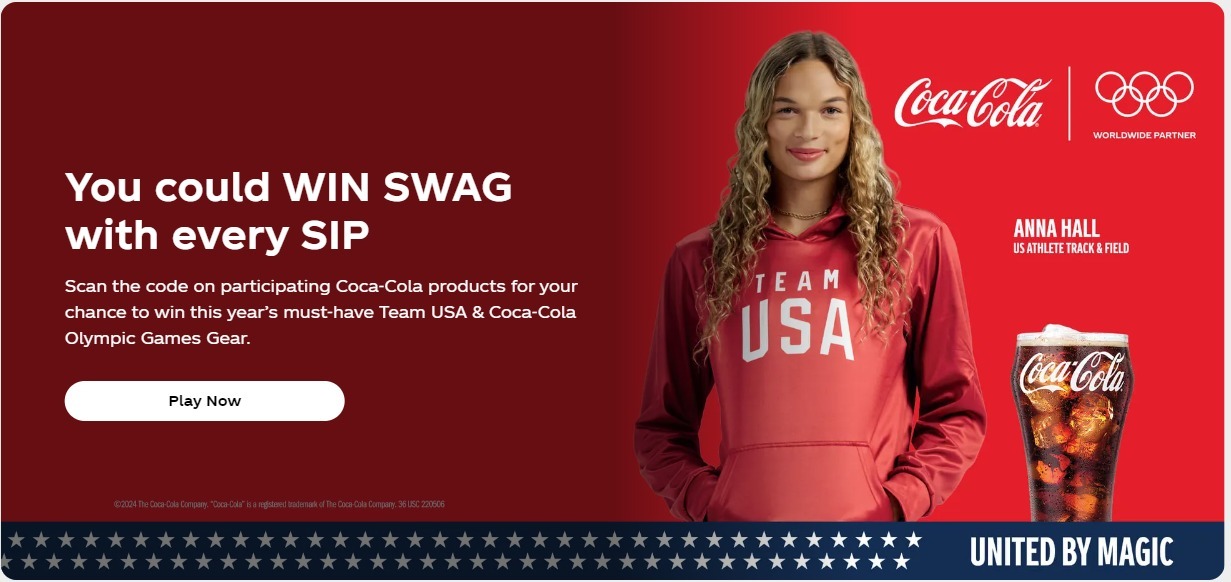
Image via Coca-Cola
You May Also Like:
- 6 Tips for Keeping Your Viral Video On-Brand
- 5 Ecommerce Trends to Increase Your Site’s Revenue In 2024
16. User Experience (UX)
Another effective strategy to increase traffic to your website is improving the user experience (UX).
A seamless and enjoyable UX can help keep a website visitor engaged, encourage them to explore more content, and ultimately drive them to take desired actions.
To ensure a seamless user experience for your site users, implement the following:
- Have an intuitive and easy to use navigation
- Optimize your website for mobile devices
- Create content that’s quality and engaging
- Make your CTAs prominent and visible
The example below is an excellent example of how to make your CTAs prominent and visible.

Image via KFC Shop
17. Collaborate with Influencers
Influencers are people who’ve built large followings on blogs or social media. When you partner with influencers that resonate with your target audience, you can leverage their expansive reach to amplify your brand’s presence.
Rather than opting for one-off promotions, consider building genuine long-term relationships with influencers.
Authentic collaborations where influencers naturally integrate your products or services into your content yield better credibility and engagement.
Here’s an example of a great influencer collaboration.

Image via Instagram
18. Social Share Buttons
Sometimes, learning how to increase website traffic involves simple human psychology. If you understand how the human brain works, you can convince people to visit your website.
Social share buttons are a prime example of this principle in action. When your site users see these buttons, they recognize that others can engage with your content, which encourages them to participate in spreading it further.
To effectively implement social share buttons, consider:
- Focus on platforms where your target audience is most active
- Make your buttons visually appealing and align them with your site’s design
- Place them strategically within your site, such as at the top or bottom
The image below is an excellent example of how to strategically place social share buttons to increase website traffic.
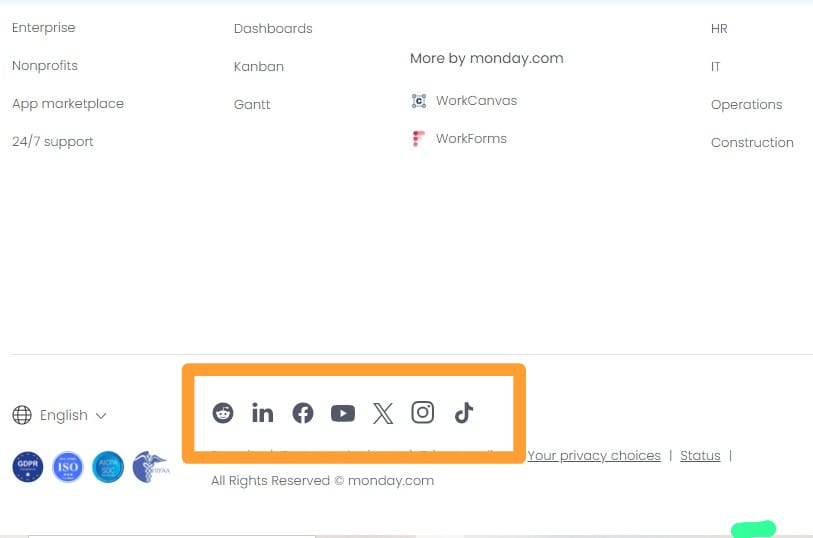
Image via Monday.com
You May Also Like:
- 11 Benefits of Conversion Rate Optimization and Best Practices
- 12 Lead Generation Strategies That Will Greatly Increase Conversions
19. CTR Optimization
A higher Click-Through Rate (CTR) usually signals to search engines that your content is relevant and valuable. This can improve your ranking in search results, leading to more visibility.
When your content appears higher on the search results page, it attracts more clicks and, consequently, more traffic to your website.
Below are some CTR optimization tips to help generate traffic:
- Craft compelling headlines with action verbs that evoke curiosity
- Write persuasive meta descriptions with a clear CTA
- Use high-quality images and engaging videos that complement your content.
20. A/B Testing
Another powerful tool you shouldn’t ignore when learning how to increase traffic to your website is A/B testing.
This technique involves comparing two versions of a web page to determine which that performs better in terms of user engagement and conversion rates.
This data-driven approach helps optimize your marketing strategies, allowing you to make informed decisions that enhance user experience and drive better results for your business.
For the best practices, consider testing a single element at a time. Also, segment your audience to understand their different preferences.
21. Internal Linking
Internal linking increases website traffic by enhancing navigation and user experience, making it easier for visitors to find related content.
Yet, internal links are crucial in guiding visitors through your blog content and finding relevant content quickly. This, in turn, reduces the bounce rate and increases the time visitors spend on your site.
To implement an effective internal linking strategy:
- Ensure the key pages on your site have ample internal links to boost their visibility
- Using descriptive and relevant anchor text that provides context about the linked page’s content
- Linking to relevant content within your site, such as blog posts, product pages, and articles just like we have done below
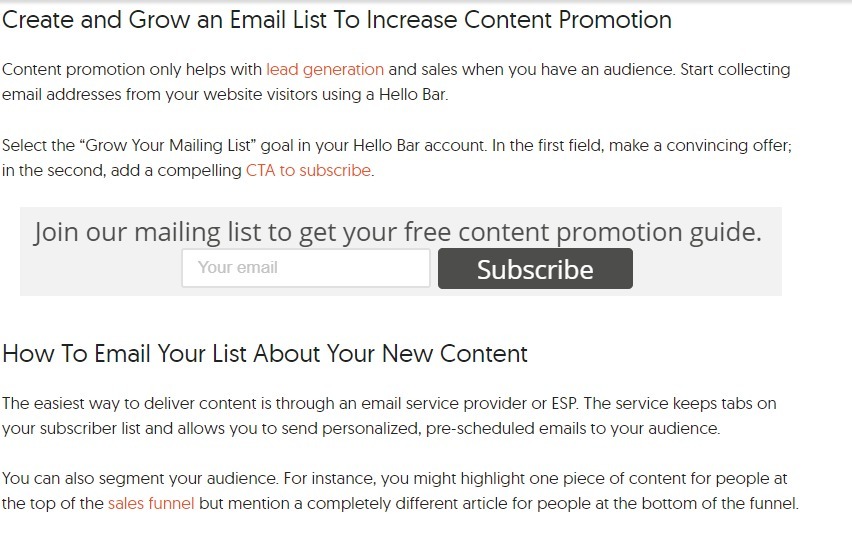
Image via Hello Bar
22. Technical SEO
Technical SEO is the backbone of your digital strategy if you are looking to drive the most relevant traffic to your site
This aspect of SEO ensures that your website is accessible to search engines and optimized for the best possible performance.
Here are the key elements to focus on to generate traffic effectively to your site:
- Site speed: Optimize your site’s images and leverage browser caching to improve load times
- Mobile friendliness: Ensure your site looks and performs well on all screens and devices
- Broken links: Regularly check for and fix broken links to maintain a seamless browsing experience
23. On-Page SEO
Optimizing your website’s on-page elements is crucial if you’re looking to drive traffic.
On-Page SEO involves implementing strategies directly on your site to enhance its visibility and relevance to search engines.
Examples include:
- Conducting thorough keyword research to identify terms and phrases your audience is looking for.
- Crafting unique and compelling meta titles and descriptions for each page.
- Using header tags (H1, H2, H3) to structure your content effectively.
24. Quality Backlinks
A successful SEO strategy involves using quality backlinks to increase website traffic and drive conversions.
But what exactly makes a backlink “quality”? It’s not just about the number of links pointing to your site; it’s about the relevance and authority of those links. A Digital PR service offered by reputable marketing agencies can help you get quality backlinks.
The most effective backlinks come from websites with high domain authority and relevance to your industry. Search engines view these links as endorsements of your content. These agencies have the link building expertise or may have white label SEO partners working with them to improve your backlink profile.
Rather than resorting to buying links or spammy tactics, aim for natural link-building methods. These include creating quality content, guest posting, and shareable resources like infographics and e-books.
25. Mobile Optimization

According to Statista, 58.67% of website traffic comes from mobile devices. As such, optimizing your site for mobile is not just a good practice — it’s a necessity.
Here are some ways you can optimize your site for mobile responsiveness:
- Speed up your site by optimizing images and leveraging content delivery networks (CDNs)
- Simplify your site’s navigation to ensure users can easily find what they’re looking for without excessive scrolling or tapping
- Use large fonts, shorter paragraphs, and ample spacing to ensure your content is still readable on smaller screens
Bonus Tips on How to Increase Website Traffic

Now that we’ve covered 25 tips on how to increase website traffic, we have a few bonus tips to share. They’ll help you boost your traffic even further and gain more insight into your visitors.
Use all of these tips or just a select few, but always test your strategies. If one doesn’t work, move on to the next.
Remember, every business’s audience is different, so what works for us might not work for you.
- Get paid traffic: Consider running paid ads to get a spike in traffic. You don’t have to run them forever. Once you have a following, you can switch to organic methods.
- Retarget visitors with Facebook Ads: Facebook, in particular, lets you target ads to people who have visited your website before. It’s a great way to bring visitors back into the fold.
- Create lookalike audiences with Facebook Ads: Lookalike audiences are also valuable. They find people who have visited your website, liked your Facebook page, or otherwise interacted with your site, then locate people in similar demographics.
- Tap into influencer ads: If you can’t find an influencer to promote your product for free, consider paying one or more influencers to talk about your product.
- Use Google Ads to promote some of your best content: Google Ads allows you to run search engine ads as well as network ads. A Google Ads freelancer is your best option if you are not confident or skilled enough to run your own ad campaigns.
- Learn SEO strategies to increase website traffic: SEO is essential to well-performing content. Get people to click on your content through paid ads.
- Find great keywords to increase website traffic for free: Consider conducting some keyword research to learn what your target audience is searching for.
- Target long-tail keywords to rank faster and get more website visitors: Long-tail keywords (keywords with more words) tend to perform best. They have less competition and are more specific to your target audience’s actual searches.
- Optimize your content with LSI keywords: While you should always start out with a primary keyword, consider using LSI (related) keywords, too. For instance, if your primary keyword is “lead generation,” LSI keywords could include “lead gen,” “get more leads,” “lead targeting,” and “generate leads.”
- Improve your click-through rate to rank better on Google: Your click-through rate is the percentage of times when people click on your content. Use compelling images, headlines, and CTAs to boost your click-through rate and make your content more attractive to Google.
Common Mistakes to Avoid
While there are many strategies to help you learn how to increase website traffic, it’s equally crucial to recognize and avoid common pitfalls.
Overlooking certain parts can hinder your efforts and waste valuable resources.
Let’s explore some common mistakes to avoid when boosting your website traffic and generating leads:
1. Neglecting Mobile Optimization
We live in a mobile-first world, and not optimizing your site for mobile devices can greatly impact your traffic. Mobile users account for a huge portion of web traffic, and a site that’s not mobile-friendly will likely lose visitors.
2. Overlooking Page Load Speed
When your website loads slowly, it can greatly frustrate users and increase bounce rates. In fact, recent research by Akamai revealed that even a one-second delay in page load time could drop conversions by 7%.
3. Creating Low-Quality Content
Content is king, but only if it offers value. Low-quality, irrelevant, and outdated content can lead to higher bounce rates and poor ranking. That’s because search engines interpret quick exits as a sign of dissatisfaction.
4. Not Engaging on Social Media
Social media is a powerful tool for driving traffic. Sadly, many businesses fail to leverage it effectively. Posting inconsistently, not engaging with your followers, and ignoring social media trends can limit your reach and visibility.
Use Hello Bar to Get the Most Out of Your Website Traffic
Attracting more website traffic is great. In fact, it’s one of the first metrics you should focus on when launching a business or website.
However, traffic becomes a vanity metric when it doesn’t produce any results. If your visitors simply consume your content and click away, they don’t hold as much value.
You want them to become leads and, eventually, customers.
Hello Bar can help you convert your website traffic. Your Hello Bar can appear wherever you want on your site and incentivize your audience to take action.
Let’s say that you want more people to join your email list. Use the “Collect Email” goal when creating a new bar.
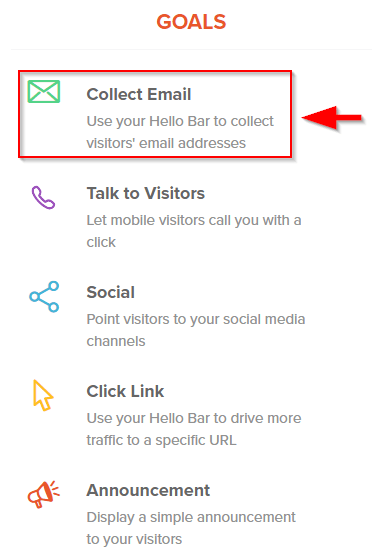
You can then customize it however you like. Decide what information to collect, how your Hello Bar should look, and even the cookie duration.
There are many ways to use Hello Bar to maximize your traffic. Encourage people to view a related article, make a special announcement with a coupon code, or invite people to follow you on social.
A/B test your Hello Bars to determine which works the best. Hello Bar makes A/B testing incredibly easy because you don’t have to wade through lots of data. Instead, the software tells you which version proved most popular.
How to use Hello Bar Feature to Increase Web Traffic
With Hello Bar, you can quickly create engaging, attention-grabbing bars at the top of your site. These bars are designed to convert visitors to leads and customers.
For instance, if you have an active Facebook account, you can use your existing web traffic to get more Facebook followers and cross-promote your social profile with your website.
Signup for Hello Bar, then create a new bar. Use the “Get Facebook Likes” goal.
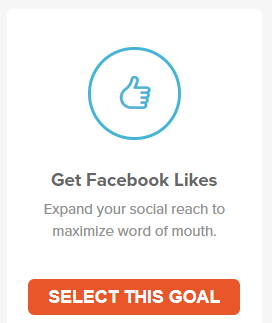
Create your Hello Bar using whatever CTA you prefer. Consider turning on the feature that allows the visitor to like the specific URL on which the bar appears.
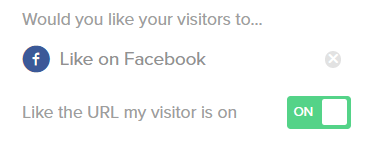
Your Hello Bar might look like this:
![]()
You can get your visitors to share your content on Facebook using this strategy. Their audiences will see the content and might even click to read it, thus increasing your website traffic.
FAQs
Q1. What is website traffic?
Website traffic refers to the number of visitors who visit a website over a specified period. This includes all types of visits, whether they are direct, organic, referral, or paid.
Q2. What are paid advertising options for increasing traffic?
Paid advertising options include social media ads, display advertising, PPC campaigns, and sponsored content. These options allow you to target specific audiences, increase your visibility, and drive traffic to your site fast.
Q3. Is paid advertising a good way to increase website traffic?
Yes, paid advertising can be an effective strategy to increase web traffic. When done strategically, it can drive targeted visitors to your site, boost visibility, and generate leads.
Here are the key reasons why paid advertising is a good method for increasing web traffic:
- Unlike organic methods, paid ads can bring immediate traffic to your site the moment your campaign goes live.
- Platforms like Google Ads and social media networks allow you to target specific demographics, interests, and behaviors, ensuring your target reaches the right audience.
- Paid search ads can place your website at the top of search results for relevant keywords. This will help increase your visibility to potential customers.
Q4. How can I retain my website visitors and convert them into leads?
To achieve this, focus on providing a great user experience, creating valuable content, and offering clear CTAs. Tools like landing pages, lead magnets, and CRM systems can also help you effectively capture and nurture leads.
Q5. What are the most effective strategies for increasing website traffic?
Here are some of the most effective strategies for driving more visitors to your site:
- Optimize your site for SEO to improve your rankings and visibility.
- Use paid advertising methods like Google Ads, social media ads, and display ads to drive targeted traffic to your website.
- Build an email list and send regular newsletters and promotional emails to keep your audience informed and engaged.
- Promote your content and engage with your audience on social media platforms.
Conclusion
Learning how to increase website traffic can help you get leads and grow your sales. By implementing these 25 proven methods, you can create a robust strategy that attracts visitors and converts them into loyal customers.
Each method provides a unique approach to driving traffic, from improving user experience and leveraging social media platforms to utilizing tools like Hello Bar.
Remember, the key to sustained growth is continuously analyzing and optimizing your strategies based on data-driven insights.
So stay adaptable, keep experimenting, and always prioritize offering value to your audience.
What’s your favorite way to increase website traffic?


